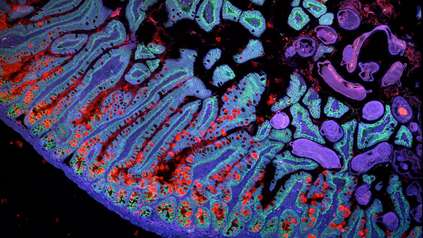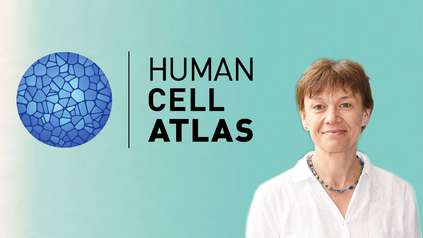New tool tracks individual immune cell development
A new tool that can uncover the developmental history of certain immune cells is now freely available worldwide. The tool provides insights into the stages that immune cells go through in a healthy individual and how this can be impacted in disease.
Researchers from the Wellcome Sanger Institute and their collaborators have created the tool, called Dandelion, as part of the Human Cell Atlas initiative*. It combines single-cell genomics data with T and B cell receptor data to give a complete view of how individual immune cells develop.
The research, published today (13 April) in Nature Biotechnology, also used Dandelion to uncover that partial recombination** of the genome occurs during development of other immune cells known as natural killer cells.
B cells and T cells are types of immune cells that are activated when they recognise markers, known as antigens, which are on or released from pathogens and cancer. They are part of the adaptive immune system, which adapts and evolves with the immune response.
During development, these immune cells go through a process known as V(D)J (variable, diversity, and joining genes) recombination. This is where selected parts of the genome are randomly cut and pasted, resulting in receptors that are as genetically diverse as possible and have a higher chance of recognising foreign antigens.
Having a complete picture of the stages of genetic recombination in immune cells allows a greater understanding of how our immune system develops and how diseases interrupt this.
Dandelion combines the genetic recombination V(D)J receptor data from B and T cells with single-cell genomic data to give a more in-depth understanding of the changes each cell went through, shedding new light on T cell development and the origins of B cells.
This is the first time that these data have been combined to see the developmental process and can be used to understand more about how the immune system produces cells in health and disease. For example, the tool can be used to give further clarity on what has happened in diseases that disrupt T cell development, such as certain types of leukaemia and immunodeficiency diseases including AIDS.
Sometimes, V(D)J recombination is not completed fully and this is known as partial recombination. Previously this was seen as a waste as it didn’t appear to help the immune cell develop any antigen recognition. However, using Dandelion, the team found that these partial recombinations occur naturally in cells not traditionally thought as part of the adaptive immune system, such as natural killer cells.
The team used Dandelion to chart the partial recombination events underlying the developmental processes of these cells and found that they actually overlap with parts of the normal T cell developmental route, but diverged to a different process before the receptors are fully rearranged.
While this process needs to be studied further to fully understand the role it plays, it highlights new insights into transcription factors and surface markers that are involved in these mechanisms. It also displays that Dandelion can be used to highlight new avenues for investigation.
“We have created Dandelion as a free tool that can be used openly all around the world, giving researchers another way to further explore immune cells in detail. We hope that it will be useful to the community for exploring lymphocyte biology in the single-cell space, generating new insights that will help advance our understanding of immune cell development and function in health and disease.”
Dr Chenqu Suo, first author from the Wellcome Sanger Institute
“B cell and T cell receptors go through a robust recombination process, that is based on trial and error, but leaves the recombination outcome as barcodes in their genetic material. Dandelion, named after the plant due to how the immune cells and secreted antibodies would circulate the body in the same way how dandelion seeds are often transported away by a gust of wind, shows these genetic barcodes. It gives us the ability to see the developmental trajectory of these cells for the first time and helps us understand the genetic mechanisms behind immune cell development.”
Dr Kelvin (Zewen) Tuong, co-senior author previously from the Wellcome Sanger Institute and the University of Cambridge, and currently at The University of Queensland
“Dandelion gives us a higher resolution view of the processes occurring in VDJ recombination. It identified partial recombination in unexpected cell types, with important implications for the developmental origin of a specific subset of more innate B cells, called B1 cells, in humans.”
Professor Menna Clatworthy, co-senior author from the Wellcome Sanger Institute and the University of Cambridge
“The Human Cell Atlas aims to detail all the cells and their interactions at different stages of life, giving novel insights into every cell in the human body. Developing new tools and analysis platforms, such as Dandelion, allows us to pull out these insights from the huge amount of data that the Human Cell Atlas is generating. Dandelion is a vital and freely available tool that allows us to understand more about the immune system.”
Dr Sarah Teichmann, co-senior author from the Wellcome Sanger Institute and co-founder of the Human Cell Atlas
More information
Dandelion is freely available, and accessible at https://github.com/zktuong/dandelion
*This study is part of the international Human Cell Atlas (HCA) consortium, which is aiming to map every cell type in the human body as a basis for both understanding human health and for diagnosing, monitoring, and treating disease. An open, scientist-led consortium, HCA is a collaborative effort of researchers, institutes, and funders worldwide, with more than 2,900 members from 94 countries across the globe. More information can be found at https://www.humancellatlas.org/
**Genetic recombination is the rearrangement of DNA sequences by the breakage and rejoining of different parts of the genome. VDJ recombination is a type of genetic recombination that occurs only in developing lymphocytes during the early stages of T and B cell maturation. Partial recombination is where the process is only partly completed, and the recombination does not lead to effective receptors.
Publication:
Suo, K. Polanski, E. Dann, et al. (2023) ‘Dandelion uses the single-cell adaptive immune receptor repertoire to explore lymphocyte developmental origins’. Nature Biotechnology. DOI: 10.1038/s41587-023-01734-7
Funding:
This research was part-funded by Wellcome. A full acknowledgement list can be found on the publication.





